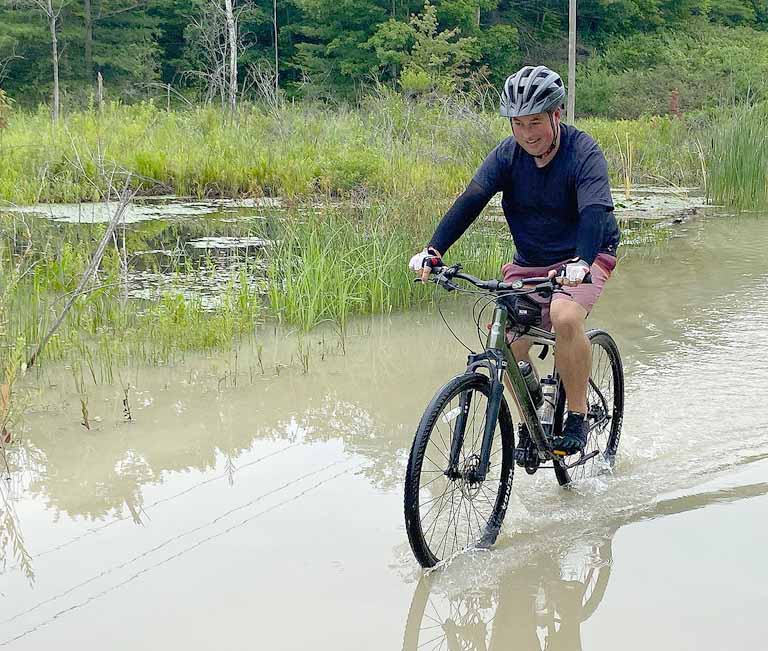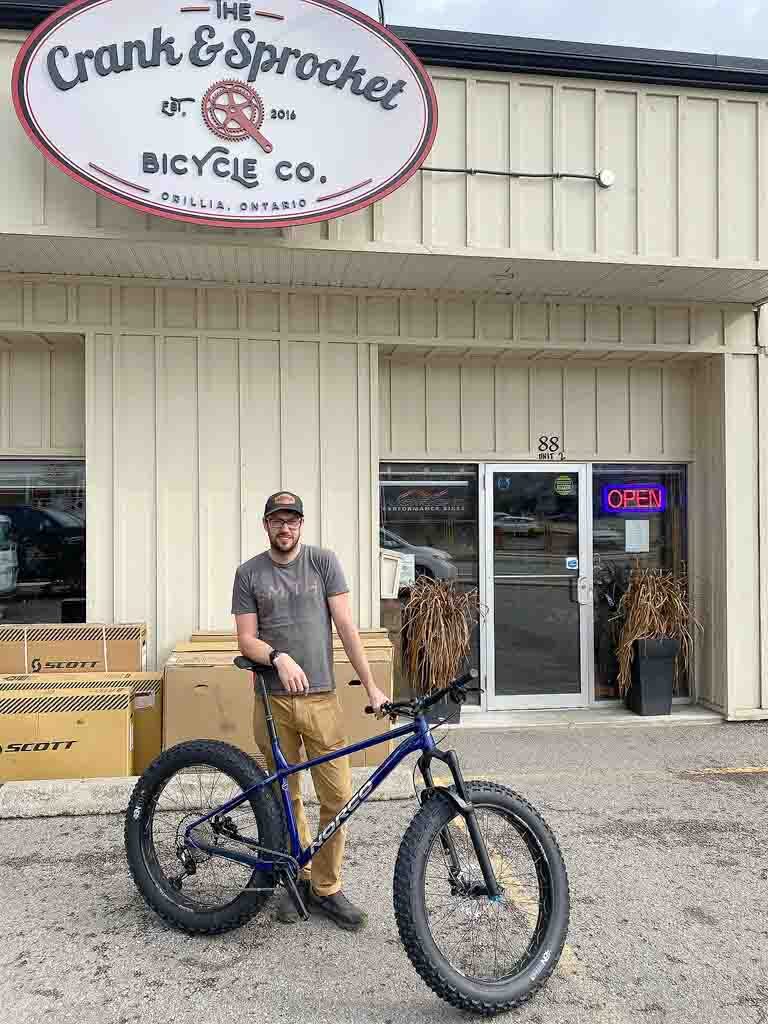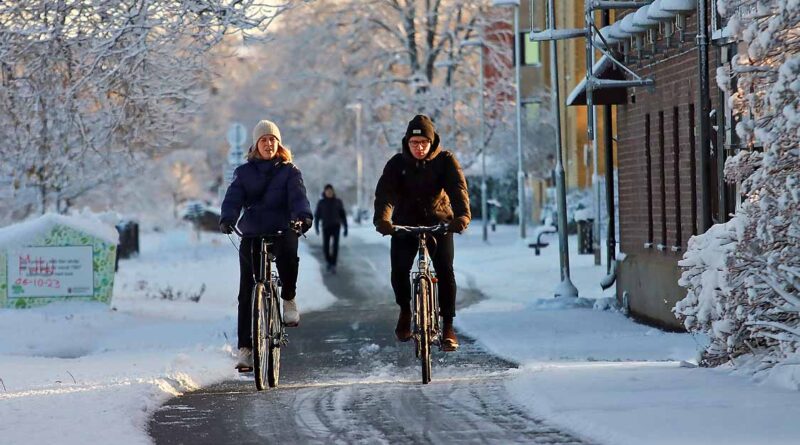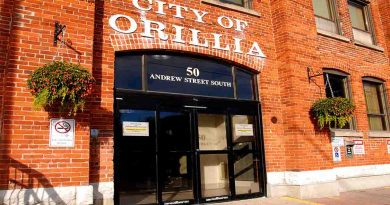Biking 365
By Gord Ball – Special to SUNonline/Orillia
As another Orillia winter approaches, many local cyclists are putting their bikes away until the snow leaves us in the spring. Not Matt Thomson of Severn Township. He rides his bike year-round.
“Most days I’m on my bike,” said Matt. “Unless the weather’s really bad. I aim for 10,000 kilometres a year. As of the end of October, I was at 7,800. I started keeping a log in 2018. In 2021 I racked up over 11,000 kilometres.”
“I’m not a heavy sports person. This is my way to get exercise. I find it relaxing. I do my best thinking on my bike. It feels good to get out in the fresh air and explore different areas that I wouldn’t normally go to in a vehicle.”
Matt knows that cycling also promotes good health, maintaining a healthy heart and playing a role in good mental health. But Matt also knows it’s not just good for his health; it’s great for the environment, too.

“I have an app that records the emissions I’m preventing. It says I prevented 220 kgs of carbon emissions in October, and saved 94.5 litres of gas, while cycling 884 kms during the month,” said Matt
Cold weather and snow doesn’t discourage Matt. He knows how to make the bike safe and comfortable – customized to his body and preferences. That means setting up his bike properly, with the right seat height. In winter good traction is also key.
”Forget the need for speed,” said Matt. “Speed is not your friend. Traction is your friend. A wider tire can give you better grip on snow or ice, and you can soften your tire pressure.”
Matt finds his studded tires are great for ice-pack. “They’re amazing. I’m impressed with these tires. They feel just like riding in any other season and give me confidence to ride in winter.” Still, if there’s more than an inch of fresh snow on the road, Matt waits for the plow to go by.
“As for cold, I don’t focus on the temperature. I wear a light jacket to keep my body heat from creating condensation inside my jacket. I dress in layers that I can adjust. Nothing too heavy. I just got a new red down jacket so I’m easily seen. I have good insulated gloves with a good grip. If it’s below minus 10, I wear a balaclava to keep my cheeks warm. I have a ski cap, too, that covers my ears and has slots on the side for my glasses. I like to wear glasses to keep the wind out of my eyes. I always keep a tissue handy.”
Matt knows that winter riding comes at a cost – constant maintenance. “Road salt is evil. Make sure to clean your bike and scrub the chain after each ride. Invest in a chain cleaner and a wet chain lubricant if you’re riding on urban streets. And invest in a decent set of mud fenders to avoid getting skunked (a splatter stripe on your back). And don’t forget to stay hydrated.”

Jacob McClelland is co-founder and co-owner of the Crank and Sprocket Bicycle Company at 88 Laclie Street in Orillia. He sees a growing number of people looking for wide-tired bikes and studded tires these days.
“We keep lots of studded tires in stock. We also get a lot of people looking for warm gloves and jackets. In-town commuters are trending towards winter bikes,” Jacob said.
“The hardest parts to keep warm are hands and feet, once you get moving, your body warms up. Lots of people like a wind-proof, mid-weight jacket. Some like a bar-mitt or handlebar cover. Clothing is the biggest part.”
He concurs with Matt’s assessment of how hard winter can be on bikes. “Salt is hard on bikes. Use a good chain lube to repel slush and salt and grime.”
Jacob does his own winter biking mostly on mountain bike trails. “Orillia does a pretty good job of keeping their waterfront trails plowed and clear,” he said.
Across Europe, more and more people are swapping cars and buses year-round for bikes. A study from the University of Southern Denmark, published by the Communications Earth and Environment Journal, urges people to ride bikes like they do in the Netherlands. Dutch people cycle an average of 2.6 kilometres each per day. In 2019, the Dutch made 4.8 billion trips by bicycle. Trips for leisure purposes account for one-third of the total distance cycled, followed by bicycle trips for shopping and commutes to and from work. If everybody cycled as much as the Dutch, global carbon emissions would drop by nearly 700 million tonnes per year. Another plus—people who cycle to work have a 45 per cent lower risk of developing cancer and a 46 per cent lower risk of cardiovascular disease.
The study authors recognize not everyone lives in a cycle-friendly place, but they call for an urgent expansion of cycling infrastructure worldwide. “Lessons learned from successful experiences in countries like Denmark and the Netherlands include the importance of proper bicycle lane planning and construction, pro-cycling education and culture, and policies to discourage car use through taxation.”
Matt Thomson is encouraged by the uptake of cycling in the Orillia area. “I’m seeing a lot more people out cycling. The City could help by investing in better infrastructure such as more bike lanes and more bike racks on public transit. Once you build it, they will come.”
(Images Supplied)




